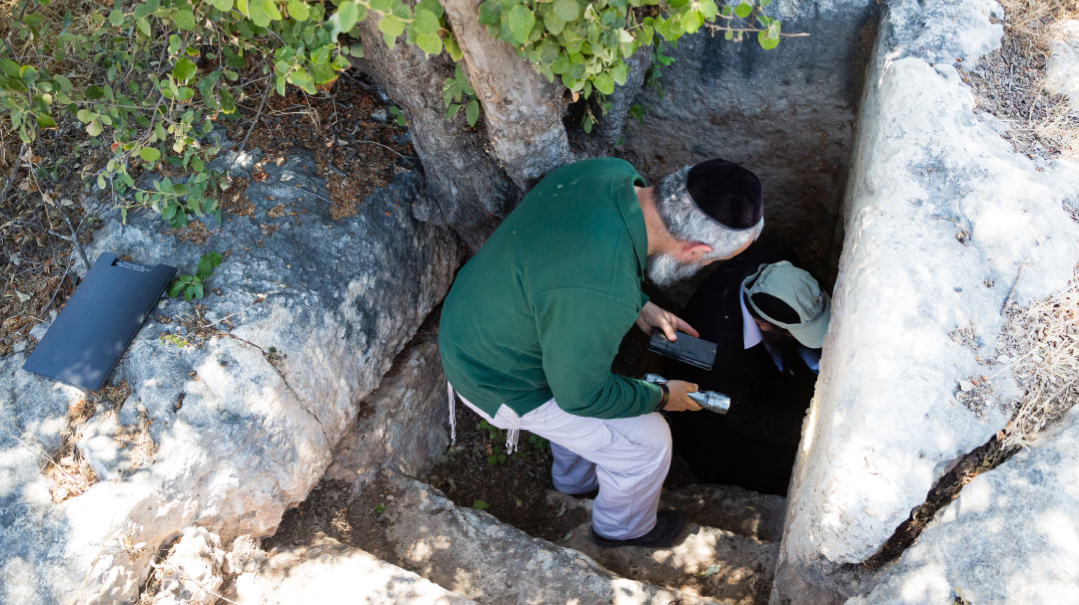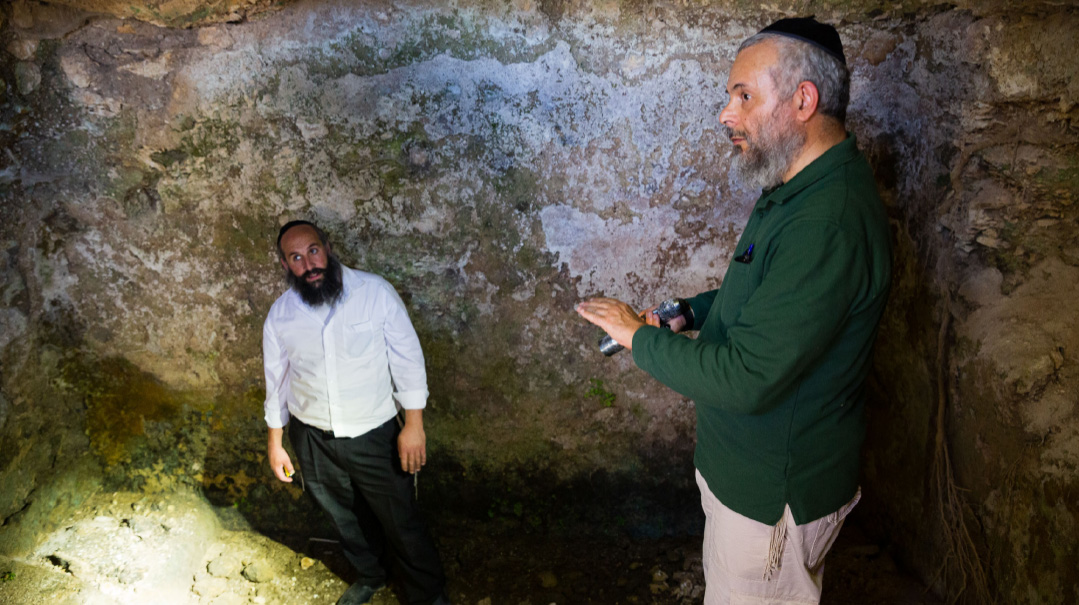Dipping into History
| July 18, 2023A hilltop network of ancient mikvaos is unearthed in Ramat Beit Shemesh

Photos: Elchanan Kotler
One thing about living in Israel’s contemporary cities is that modern highways, highrise apartments, and other state-of-the-art amenities often find themselves side-by-side ancient ruins — almost like having a 2,000-year-old neighbor in your backyard. Residents of Jerusalem’s Sanhedria neighborhood, for example, don’t even bat an eye at the ancient burial caves of the Sanhedrin that abut their homes.
And now, residents of the new neighborhood of Ramat Beit Shemesh Gimmel (part of a network of the ever-expanding city whose ancient roots go all the way back to the era of the Shoftim) can greet history right outside their door: All they have to do is cross the traffic circle intersection of Eliyahu Hanavi and Yeshayahu Hanavi Streets, and they’ll find themselves in a time warp. Because right at the edge of those new buildings is an open field that has become a recent treasure of the archaeology community — an entire hill filled with ancient mikvaos.
We’re accompanying Reb Nissan Levron, who has become a familiar figure on this hill. Reb Nissan, a longtime resident of the Jerusalem suburb of Beitar, is an editor of Jewish texts, a researcher, a writer for the Hidabroot kiruv organization, a natural health practitioner, and a tour guide specializing in biblical archaeology and Jewish history excursions off the beaten track around Eretz Yisrael.
Standing on this hill, called Givat Hamikvaot (“Mikveh Hill”), Reb Nissan points out the surrounding historical attractions not far from where we are: the Elah Valley and the ancient cities of Azekah and Socho on either side, where the iconic battle of David and Goliyas took place; the ruins of Churbat Etri, a former city from the time of the Second Beis Hamikdash, and the ancient King David–era city of Shaarayim with its two distinct gates.
But what interests him most is the very hill where we’re standing, a testament to halachic adherence and mesirus nefesh that prevailed among the remaining Jews of Eretz Yisrael even after the country was overrun by the Romans and so many residents assimilated to the side of Roman culture.

“You don’t need carbon dating here,” says mikveh guide Nissan Levron. “Such mehudar mikvaos only existed where there were Jewish settlements who were strict about taharah”
Purity at All Costs
Standing here on Givat Hamikvaot, we can’t help but feel a strong — and proud — connection to the ancient dwellers. Here, Levron tells us, there was an ancient Jewish settlement called Beit Netif. And the proof of their commitment to halachah is etched, dug, and indelibly marked in stone wherever we look.
“On this hill,” Reb Nissan reveals, wondering if the families across the street even know, “there are no less than ten mikvaos that have been preserved exactly as they were 2,000 years ago. Because there are so many of these mikvaos within a relatively small area, we assume that each family actually had their own private mikveh.
“You can climb down into them and examine them up close, literally feeling how the past comes to life for us,” he continues. “Yet with all the building happening on all sides as Beit Shemesh stretches to meet its new municipal boundaries, we need to hope that just like these mikvaos were not destroyed during the thousands of years, despite all the peoples who lived in the village for all these centuries, we won’t be the ones to destroy them.”

Even Under Siege
For experts in the halachos of mikvaos, this hill is especially exciting — because each of these mikvaos is mehudar. For this tour, we’re joined by mikveh expert Rabbi Mendel Rand of the national Mercaz Taharas Hamishpachah organization responsible for building mikvaos in outlying areas around the country. Rabbi Rand, tape measure in hand, descends the stairs of this ancient pool. Aside from a myrtle bush that’s made itself comfortable growing inside where the water has pooled, the mikveh is fully intact: the stairs are carved into the stone, and after we descend behind Rabbi Rand and Reb Nissan, we discover that we’re standing in a large room hewn into the earth, the floor of which is on a slight incline.
Rabbi Rand gets down on his knees and takes out a tape measure. “Mehudar!” he rules. “L’chatchilah shebel’chatchilah!”
He proceeds to check the other mikvaos, and together with Nissan Levron, will try to determine if the little chambers near the mikvaos were indeed built to serve as an otzar, the collection area for the water, or if they were perhaps built later by those who settled into the homes where the Jews of Beit Netif lived before they were either expelled or murdered, and whether the new residents turned the mikvaos into grain storage rooms.
The stairs that are in the bor of the mikveh itself match the words of the Shulchan Aruch (Yoreh Deiah 198:31): “And one needs to make in their place a step of stones, and it should be a wide step in the place where the foot is placed.” Was the step built especially so that people could stand and immerse while on it, or was it only meant to serve as a way to access the level beneath it?
Some of these questions have remained unanswered, but what is clear is that these mikvaos are testimony to a once-vibrant Jewish life, even after the destruction of the Second Beis Hamikdash. For underground on this hill are also a series of tunnels and hideaways, dated to the time of the three-year-long Bar Kochva revolt 60 years after the Churban. This was a time when Jews had to go into hiding to learn Torah, when hundreds of thousands of residents had been murdered or shipped off to the Roman slave market, when Jewish life in Eretz Yisrael, for so many who remained, felt hopeless.
Even during the revolt, when residents and fighters lived in that network of underground bunkers, they found a solution to preserve taharah. They forged an opening to allow access from the bunker to one of the large mikvaos on the hill, so that they could immerse even during a siege or fighting.
“There’s no need to conduct carbon dating or to check the type of plaster that was used, as is usually done when we find archeological remains,” Levron says. “Such mehudar mikvaos only exist in places where there were Jewish settlements who were strict about taharah.” He quotes Professor Ronny Reich, an international authority on ancient mikvaos, who has determined that the right turn of the stairs descending into the immersion cavity is found in numerous mikvaos from the Bayis Sheini era.

Rabbi Meir Rotter: “Because of the industry here, they would be expected to be especially strict about taharah”
Never Too Careful
According to Rabbi Meir Rotter, a lecturer and expert on halachahic aspects of the Second Temple period, the residents of this community were especially careful about laws of ritual purity.
“The residents primarily used stone utensils, which are more difficult to produce and more cumbersome to use, but the advantage is that they don’t absorb impurity. And as we know from where we’re standing, there was a mehadrin mikveh built alongside each house, which gave the people access at any time. It’s also an indication that the Jews who lived here were well-heeled, which correlates with the many vessels that were found here.”
With the many stone presses scattered around us, it’s clear that the residents of Beit Netif produced wine and oil. In addition to the large presses used for wholesale production, we also find small presses — saflulim (from the term sefel or large cup), that were used to produce wine in the home.
“Because of the industry here, they would be expected to be especially strict about taharah,” Rabbi Rotter explains. “It means that the residents would have to immerse themselves a number of times a day, so these mikvaos were actually an integral part of their life.”
It’s also an indication of the hope the Jews harbored that the Mikdash would be speedily rebuilt, and they would once again be able to sacrifice korbanos in purity. Only after the defeat of Bar Kochva did the settlement meet its bitter end — the residents either murdered or exiled to Rome.

A Reason to Worry
You’d think that Nissan Levron, Rabbi Rotter, and the others would be thrilled to have such clear regards from the past, so why are they worried?
“Alongside the mikvaos and presses that were discovered, there are areas that are still covered in dirt, which means the Israel Antiquities Authority hasn’t really invested much of an effort here,” says Reb Nissan.
In fact, Ramat Beit Shemesh construction was supposed to continue right up this hill, before the mikvaos were discovered. And they’re not sure how protected the area actually is, despite assurances from the IAA, the Housing Ministry, and the Beit Shemesh municipality.
They’re petitioning for the area — really quite small, at about 500 square meters — to be designated as a preserved heritage site, although right now, it seems that according to the map of the national park that’s to be established here, the park incorporates the ruins of the nearby Byzantine church, but not of Givat Hamikvaot. According to a Housing Ministry spokesman, the hill was not originally included in the park boundaries, but confirms that it will be designated in the new development plans as a protected site.
And then, just like the residents of Sanhedria, those in Ramat Beit Shemesh will consider their 2,000-year-old neighbors another honored group in the neighborhood.
(Originally featured in Mishpacha, Issue 970)
Oops! We could not locate your form.







